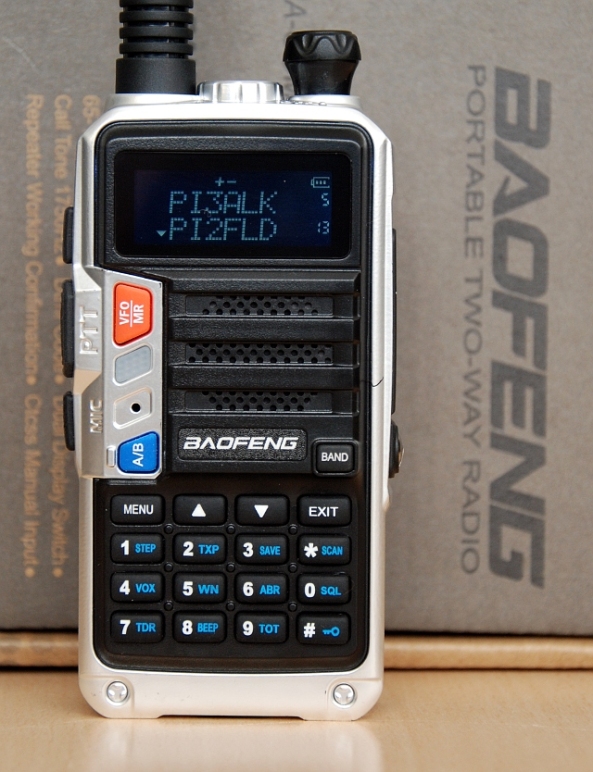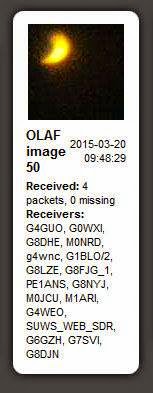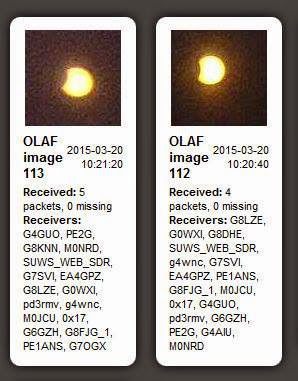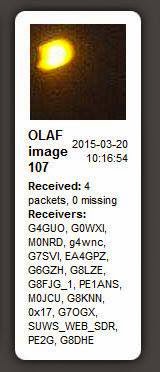Posts Tagged ‘amateurradio.com’
 I am now the Chairman of a radio club!
I am now the Chairman of a radio club!
This week South Kesteven ARS (SKARS) held an EGM where I was voted on as the new Chairman. Nigel Booth M0CVO has stepped down following four years in the position citing increasing business commitments. Nigel intends to remain an active member, I and the other members wish to thank Nigel for his efforts over the years and wish him well with his business ventures.
SKARS has a small membership at present which we hope to increase but the committee finds itself in the Catch-22 position of not having a lot of funds in order to put on activities and promote ourselves to increase the membership.
I have created a social media presence in the form of a Facebook page and twitter account in addition to updating the societies web page.I am hoping that permission willing the GB2EGG and Eggsplorer-1 project will significantly promote the society and the hobby.
I know running a club/society isn't a trivial undertaking, especially if working full time having chaired a large dog agility training club many years ago. It can take a lot of effort and time and it can sometimes be a thankless task.
Indeed my first twenty-four hours has Chairman saw my first sacrifice, a lovely Yaesu FT-450D was delivered yesterday and I have yet to take it out of the box!
Something to be remedied this evening.
 Eggciting HAB projects
Eggciting HAB projects
In June my club South Kesteven Amateur Radio Society (SKARS) will be operating a special event station at the Swaton Vintage Day held at Thorpe Latimer in Lincolnshire.
The 2015 Swaton Vintage Day will also host the 10th World Egg Throwing Championship and in recognition the special event station will have the call sign GB2EGG. This popular annual show raises money for local, national and international good causes.
Egg Throwing is recognised by the English Sports Council and the sport is taken very seriously by some competitors. Hundreds of competitors from Europe and around the world are expected to compete this year. Last year’s event attracted teams from Germany, Slovenia, Hong Kong and Brazil.
While planning the special event station I jokingly suggested throwing an egg in to space on board a balloon, I shouldn't have yoked as it is now a serious project. The idea coming from Dave Akerman's Spudnik flight for Heston Blumenthal’s Channel4 television program.
 |
| Image with the permission of Dave Akerman |
On board cameras will record the journey to be recovered on a successful return to Earth. Radio enthusiasts all around the country will be able to assist receiving the data and pictures and track the progress of the flight via the UK High Altitude Society tracking website.
More details and progress will be posted on here and on the Eggsplorer-1 website and you can follow developments on twitter @eggsplorer1South Kesteven ARS welcomes anybody with an interest in radio communications, so if want to be involved in this and other events like this please visit us at the show or visit the South Kestevan ARS website and on twitter @M0SKR
I have already begun development of the payload, unlike the moth-balled NERD-1 payload this one will use one of the Raspberry Pi boards since I want to transmit SSDV images live and it supports its own specially designed camera modules. NERD-1 will still fly as a backup tracker.
Dave Akerman (M0RPI) and Anthony Stirk (M0UPU) have developed the Pi-In-The-Sky ready made boards and the design and software are open-sourced, using this as a starting point together with Phil Heron's (MI0VIM) SSDV software I quickly had a prototype dubbed NERDPI running.
I did have an issue since the GPS module I currently have only outputs serial data so had to use one of those small TTL USB-Serial adapters and spun some of my own code to get the data out and was soon successfully decoding my own transmissions from the shack and uploading them to the Habhub system.
Today has seen the spectacular partial solar eclipse here in the UK, during the eclipse several HAB flights were launched to try to capture images above any cloud cover (details here) Fellow SKARS members and members from the Grantham ARC were keen to decode the SSDV images themselves as the BBC Stargazing Live balloons were flying from nearby Leicester.
So on Wednesday I did a talk and demonstration to show how to track and decode the images, it was well received and I uploaded pictures of the audience to the system.
Here in Newark the sky was beautifully clear so the eclipse was visible and spectacular, where OLAF was flying was covered in cloud, so the mission was a success.
 "QRL?" – please !!!!!
"QRL?" – please !!!!!
I was involved in a 2X QRP QSO on 14.060 MHz with Tom, KC9RXI in WI. He was about a 449 to me; and I'm sure I was no better to him, but we were having a QSO. I'm sure at times, that to people who may have been listening to the frequency, that it sounded like it was dead.
It wasn't.
All of a sudden, out of the blue, another QRPer started calling CQ/QRP on frequency! The call will be omitted to prevent embarrassment (but it is forever burned into my brain). Not so much as a single, solitary "QRL?"
Yes, I am sure that both Tom and I were weak, but we WERE in the middle of a QSO. Coming on to a frequency, plopping yourself down and commencing to call CQ without asking is just - arrgh! And to top it off, the CQer was calling CQ DE WXXXX/QRP !!!! I'm sorry, but QRPers, above all Amateur Radio ops, should know better. No excuse - period. If he had sent "QRL?" waited for a bit AND THEN had started calling CQ on top of us, I may still have been annoyed, but I would have thought to myself, "Well, he just didn't hear us."
Unfortunately, while Tom was trying to talk to me, I had to transmit "QRL. PSE QSY". He immediately QSYed (so he was able to hear me!), but at that point I had lost what Tom was trying to say. Shortly after that the QSB went off the Richter scale and the QSO came to a premature end. The "meat" that I could have copied was drowned out forever by needless QRM.
A bit after that debacle, I went to 12 Meters and tuned around for a bit. I heard 7QAA in Malawi quite loudly. He was loud enough to work - even QRP. I don't think I broke the pile up, as again there was a lot of QSB. If I had more time (lunch hour was running out) I'm pretty darn certain I would have worked him. This time I had the patience - I ran out of minutes.
So , even with the G4 geomagnetic disturbance, Malawi was coming in the best I've heard them so far. Go figure. Luckily, the station will be on the air until early April and I'm taking a vacation day on Friday. I just may make it into their logbook yet!
72 de Larry W2LJ
QRP - When you care to send the very least!
 Review Baofeng FF-12P (UV-5X)
Review Baofeng FF-12P (UV-5X)
Probably because Baofeng is running out of letters (although I didn’t see the Baofeng UV-5Y or Z yet), there’s a new numbers game in order. The FF-12P is essentially a UV-5X and my sample came in…. silver.
 The radio houses the latest chip set and firmware. Pressing various keys confirm this: pressing ‘0’ for a bit more than a second shows the battery voltage, pressing PTT + Band generates 2100 Hz, PTT + A/B generates 1750 Hz, and PTT + VFO/MR generates 1450 Hz.
The radio houses the latest chip set and firmware. Pressing various keys confirm this: pressing ‘0’ for a bit more than a second shows the battery voltage, pressing PTT + Band generates 2100 Hz, PTT + A/B generates 1750 Hz, and PTT + VFO/MR generates 1450 Hz.
The display is of the inverse type, the antenna the short one we all learned to hate, “FF-12P” is printed on both the left and right side of the radio. Batteries / accessories aren’t compatible with the standard UV-5R. While I could find enough suppliers of the FF-12P and UV-5X, not a single one appears to sell spare batteries or any other accessory.
Charger / battery combination
I wasn’t able to charge the battery at first, because the battery and charger don’t match: the two indentations of the battery prevented it from being inserted in the charger. After scraping away enough plastic in the charger I got it to fit.
CHIRP
CHIRP recognized the radio as being a UV-5R and squelch thresholds could be modified without a problem.
Scanning
A clip on YouTube suggested that the UV-5X / FF12P scans faster. This proves to be true: the FF-12P outperforms all other Baofeng radios I own, including the GT-3 Mark II. Scan speed is about 5-6 channels/sec.
Transmitter
Frequency accuracy of the sample: +2 Hz on VHF, -11 Hz on UHF.
Power output VHF: (@ 15 MHz): 4.1 Watts (high), 1.7 Watts (low)
Power output UHF: (@ 435 MHz): 3.6 Watts (high), 1.8 Watts (low)
TX Audio: Bright and loud. Very nice.
Harmonics: the usual peaks on VHF and UHF. Still not very impressive.
Receiver
RX Audio: good.
Front-end: surprisingly good, just like the GT-3 Mark II. Nice.
Sensitivity: -127 dBm (VHF), -125 dBm (UHF). These are good numbers.
Conclusion
The FF-12P aka UV-5X is the typical Baofeng: value for money, but not without its flaws. Harmonic suppression is a mixed bag and the lack of accessories is a potential problem.
The fact that I had to modify the charger to make the battery fit is a dumb factory mistake. The short stock antenna just doesn’t want to die — put a few bucks aside to buy a better one.
The positive side of the radio is the good receiver, good TX audio and faster scan speed. And, if you care about such things, it comes in shiny SILVER!
 Review Baofeng FF-12P (UV-5X)
Review Baofeng FF-12P (UV-5X)
Probably because Baofeng is running out of letters (although I didn’t see the Baofeng UV-5Y or Z yet), there’s a new numbers game in order. The FF-12P is essentially a UV-5X and my sample came in…. silver.
 The radio houses the latest chip set and firmware. Pressing various keys confirm this: pressing ‘0’ for a bit more than a second shows the battery voltage, pressing PTT + Band generates 2100 Hz, PTT + A/B generates 1750 Hz, and PTT + VFO/MR generates 1450 Hz.
The radio houses the latest chip set and firmware. Pressing various keys confirm this: pressing ‘0’ for a bit more than a second shows the battery voltage, pressing PTT + Band generates 2100 Hz, PTT + A/B generates 1750 Hz, and PTT + VFO/MR generates 1450 Hz.
The display is of the inverse type, the antenna the short one we all learned to hate, “FF-12P” is printed on both the left and right side of the radio. Batteries / accessories aren’t compatible with the standard UV-5R. While I could find enough suppliers of the FF-12P and UV-5X, not a single one appears to sell spare batteries or any other accessory.
Charger / battery combination
I wasn’t able to charge the battery at first, because the battery and charger don’t match: the two indentations of the battery prevented it from being inserted in the charger. After scraping away enough plastic in the charger I got it to fit.
CHIRP
CHIRP recognized the radio as being a UV-5R and squelch thresholds could be modified without a problem.
Scanning
A clip on YouTube suggested that the UV-5X / FF12P scans faster. This proves to be true: the FF-12P outperforms all other Baofeng radios I own, including the GT-3 Mark II. Scan speed is about 5-6 channels/sec.
Transmitter
Frequency accuracy of the sample: +2 Hz on VHF, -11 Hz on UHF.
Power output VHF: (@ 145 MHz): 4.1 Watts (high), 1.7 Watts (low)
Power output UHF: (@ 435 MHz): 3.6 Watts (high), 1.8 Watts (low)
TX Audio: Bright and loud. Very nice.
Harmonics: the usual peaks on VHF and UHF. Still not very impressive.
Receiver
RX Audio: good.
Front-end: surprisingly good, just like the GT-3 Mark II. Nice.
Sensitivity: -127 dBm (VHF), -125 dBm (UHF). These are good numbers.
Conclusion
The FF-12P aka UV-5X is the typical Baofeng: value for money, but not without its flaws. Harmonic suppression is a mixed bag and the lack of accessories is a potential problem.
The fact that I had to modify the charger to make the battery fit is a dumb factory mistake. The short stock antenna just doesn’t want to die — put a few bucks aside to buy a better one.
The positive side of the radio is the good receiver, good TX audio and faster scan speed. And, if you care about such things, it comes in shiny SILVER!
 Anytone Tech models, additional notes
Anytone Tech models, additional notes
Overall, reviewing these Anytones was a pleasant experience. After the reviews I looked into a few other things.
- The batteries of the ANILE-8R (1300 mAh) and the NSTIG-8R (1800 mAh) are exchangeable.
- The belt clips used on the ANILE-8R and NSTIG-8R are never a perfect fit. With the 1300 mAh battery there’s a gap (easy to lose a radio that way), with the 1800 mAh battery it’s too tight.
- The antenna on the NSTIG-8R heats up fast at maximum RF output; the behavior resembles that of a Baofeng UV-5R stock antenna. The antenna appears to be reasonably efficient though. More tests are in order.
- No such problems with the antennas of the ANILE-8R, the TERMN-8R or OBLTR-8R.
- The NSTIG-8R, TERMN-8R and OBLTR-8R can display the remaining battery voltage. Measurements show that the radios are surprisingly accurate. If the radios say “8.1 Volts”, it really is 8.1 Volts. The ANILE-8R will round it down/up to the closest integer.
- The TERMN-8R is difficult to use on SW because it defaults to 10 KHz steps. SW stations are 5 KHz apart, not 10 KHz. You can use the keypad to enter the correct frequency though. I had the bug confirmed by John; it’s now on the ‘to do’ list and will be fixed.
- The more I had the TX audio compared by other hams, the more impressed I (and they) became.
- There’s an odd problem concerning spectral purity with all x-band capable hand helds I reviewed. It only occurs when both VFOs are active; we (me and a few more knowledgeable RF lab gurus) are looking into that right now.
 Anytone Tech models, additional notes
Anytone Tech models, additional notes
Overall, reviewing these Anytones was a pleasant experience. After the reviews I looked into a few other things.
- The batteries of the ANILE-8R (1300 mAh) and the NSTIG-8R (1800 mAh) are exchangeable.
- The belt clips used on the ANILE-8R and NSTIG-8R are never a perfect fit. With the 1300 mAh battery there’s a gap (easy to lose a radio that way), with the 1800 mAh battery it’s too tight.
- The antenna on the NSTIG-8R heats up fast at maximum RF output; the behavior resembles that of a Baofeng UV-5R stock antenna. The antenna appears to be reasonably efficient though. More tests are in order.
- No such problems with the antennas of the ANILE-8R, the TERMN-8R or OBLTR-8R.
- The NSTIG-8R, TERMN-8R and OBLTR-8R can display the remaining battery voltage. Measurements show that the radios are surprisingly accurate. If the radios say “8.1 Volts”, it really is 8.1 Volts. The ANILE-8R will round it down/up to the closest integer.
- The OBLTR-8R is difficult to use on SW because it defaults to 10 KHz steps. SW stations are 5 KHz apart, not 10 KHz. You can use the keypad to enter the correct frequency though. I had the bug confirmed by John; it’s now on the ‘to do’ list and will be fixed.
- The more I had the TX audio compared by other hams, the more impressed I (and they) became.
- There’s an odd problem concerning spectral purity with all x-band capable hand helds I reviewed. It only occurs when both VFOs are active; we (me and a few more knowledgeable RF lab gurus) are looking into that right now.

























